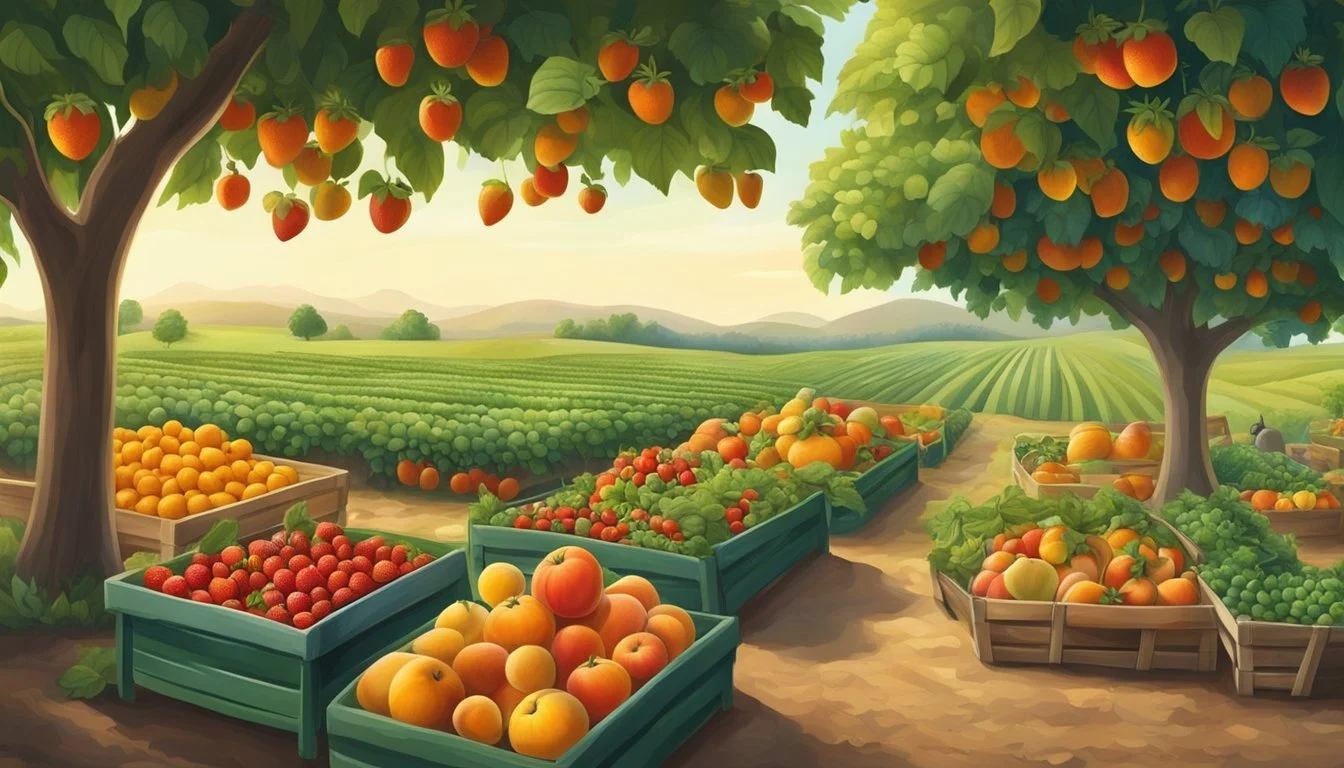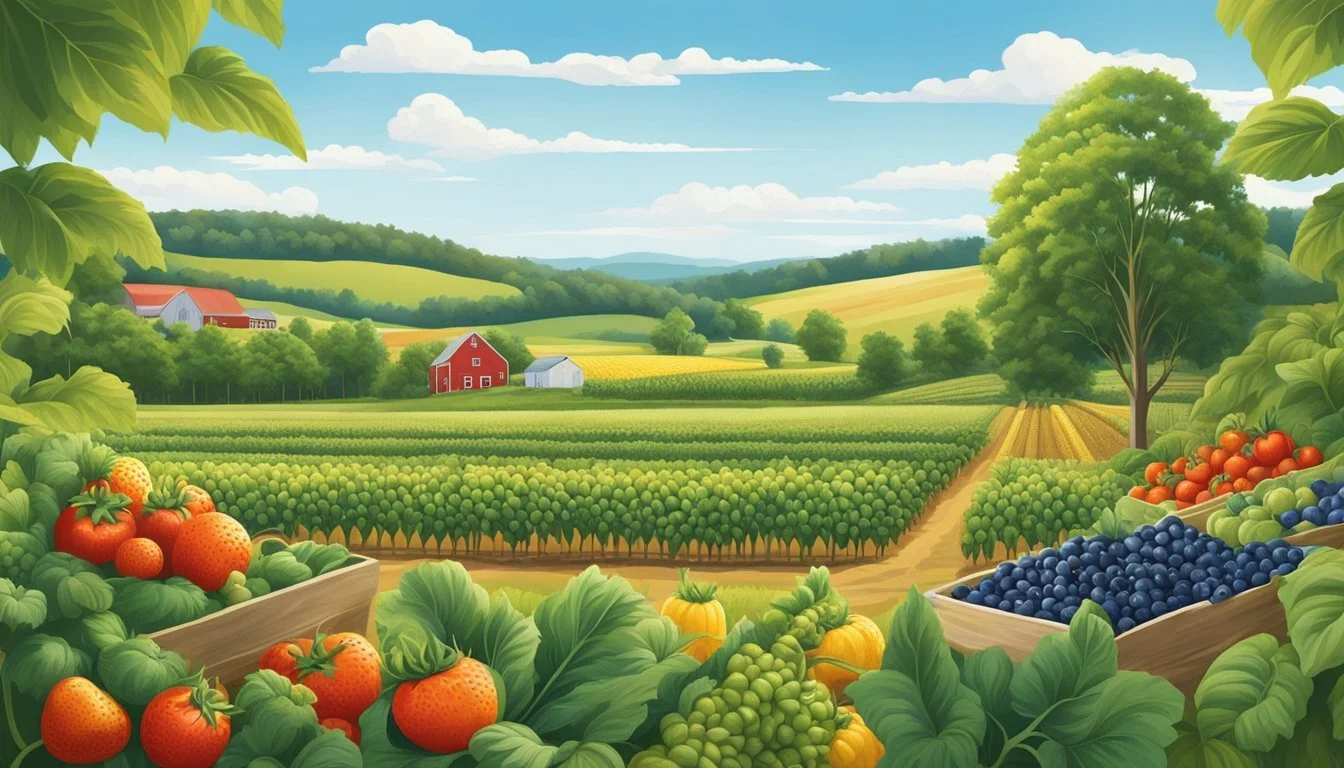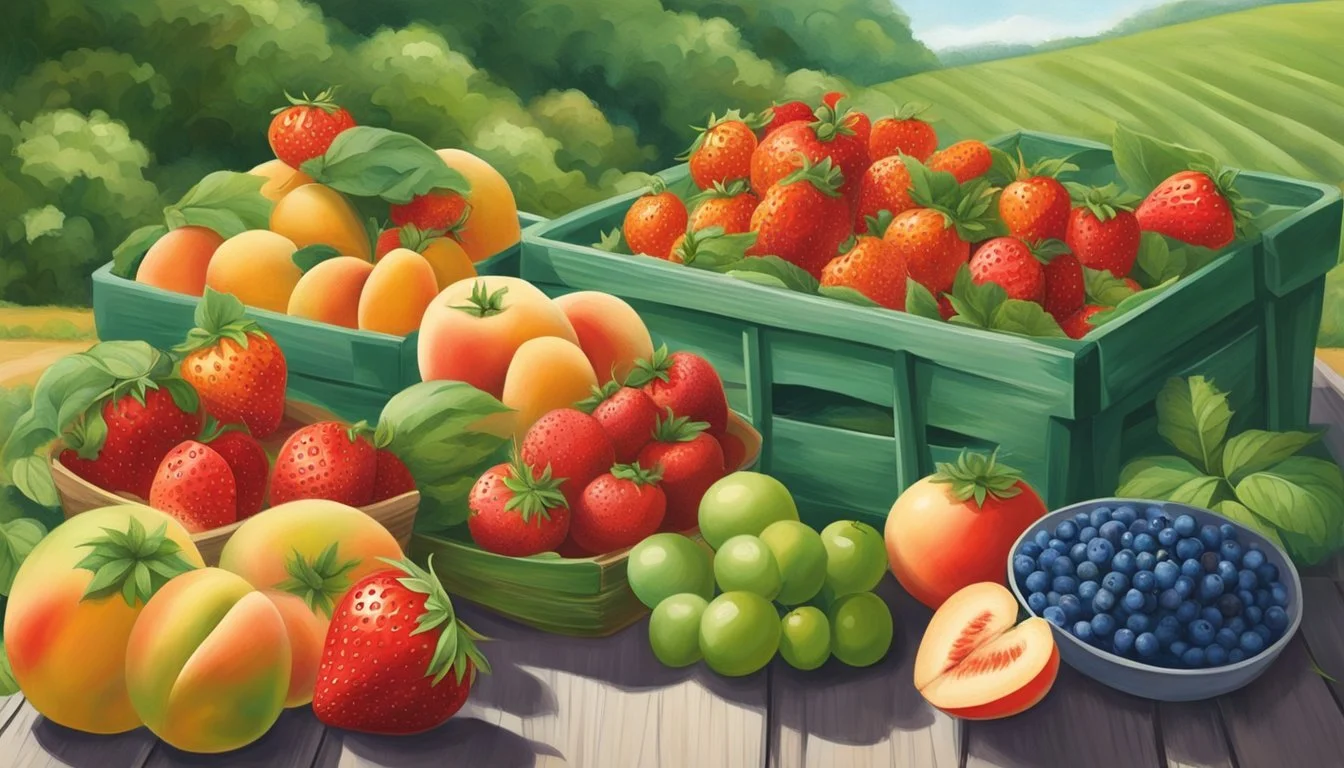Tennessee Seasonal Fruit & Vegetables in June
Your Guide to Fresh Produce
This Article is Part of our Tennessee Seasonal Fruit & Veg Calendar
June in Tennessee heralds the arrival of a rich tapestry of fruits (What wine goes well with fruit?) and vegetables, with gardens and farms throughout the state reaching a peak in variety and abundance. This period captures the essence of the growing season, where the climate favors a broad range of produce. With warm days and mild nights, conditions are ideal for cultivating a diverse selection of crops that are not only fresh but also at their nutritional peak.
During this month, farmers' markets and roadside stands brim with fresh produce. Consumers have the opportunity to indulge in the freshest and most flavorful fruits and vegetables, often just hours after harvest. Staples such as tomatoes, cucumbers (how long do cucumbers last?), and peppers begin to appear in increasing quantities, while stone fruits like peaches offer a succulent treat for those seeking something sweet. Leafy greens continue to thrive, and root vegetables, like beets and carrots, add vibrant color and earthy flavors to the local fare.
Tennessee’s agricultural calendar marks June as a prime time for berries, with strawberries coming to the end of their season and blueberries (how long do blueberries last?) entering their peak. These berries, along with the continuation of the harvest for other small fruits like raspberries and blackberries (how long do blackberries last?), make the month especially popular for those interested in picking their own fruit. The practice not only supports local farmers but also provides individuals with the freshest possible experience, connecting them directly to the source of their food.
Overview of Tennessee's Growing Seasons
Tennessee's agricultural success can be attributed to its variation in hardiness zones and a climate that accommodates a diverse range of seasonal produce. Strategic planting ensures a variety of fruits and vegetables throughout the year.
Understanding the Hardiness Zone
Tennessee is characterized by multiple hardiness zones ranging from zone 5a in the mountainous eastern regions to zone 7b in the warmer southwestern parts. These zones are crucial in determining the types of crops that can thrive and the best planting times. For instance, zone 5a supports cold-tolerant crops through tough winters, whereas zone 7b allows for a longer growing season, beneficial for warm-season crops.
Seasonal Shifts in Fruit and Vegetable Availability
The produce availability in Tennessee shifts significantly with the seasons, influenced by a route through spring, summer, fall, and winter. In the summer, one can expect a variety of fruits including peaches and berries that enjoy the warmth of the region. Fall brings about cool-season crops such as broccoli and spinach, suited to the mild decline in temperature. Some hardy vegetables can even persist into the early winter or reemerge in the spring. The state's diverse climate ensures year-round availability with certain fluctuations at the start and end of each season affecting yield and quality.
Fruits Available in June
In June, Tennessee's diverse climate nurtures a variety of fruits into peak ripeness. Consumers can relish the fresh, sweet flavors of locally grown produce that are perfect for summer recipes and snacking.
Berries in Season
Blueberries and blackberries flourish in June, providing a bounty of flavorful options for Tennessee residents and visitors. These berries are not only prime for direct consumption but also ideal for jams, desserts, and fresh salads.
Blueberries: Reach their peak, offering a balance of sweet and tangy notes.
Blackberries: Become readily available and are known for their deep, rich flavor.
Stone Fruits Reaching Maturity
Stone fruits, named for their hard central "stone," start to reach maturation in June. Cherries (how long do cherries last?) arrive early in the month, while peaches and plums follow closely behind, each with distinct textures and flavors.
Cherries: Debut in early June, with their signature red hue and juicy consistency.
Peaches: Provide a succulent and fuzzy-skinned option later in the month.
Plums: Emerge with a variety of colors and a balance of sweet and tart profiles.
Vegetables to Harvest in June
In June, Tennessee gardens are ripe with a variety of vegetables. Gardeners can expect to harvest leafy greens, pungent herbs, succulent root vegetables, as well as flavorful nightshades and cucurbits.
Leafy Greens and Herbs
Kale: Hardy and nutritious, kale is ready for picking throughout June.
Lettuce: Expect a bounty of lettuce, perfect for summer salads.
Spinach: Early June usually sees the last of the spring spinach harvest.
Collard Greens (how long do collard greens last?): These can continue to be harvested if planted earlier in the season.
Parsley: Fresh parsley is commonly harvested this month for its bright flavor.
Herbs such as parsley thrive in June, adding fresh flavors to a plethora of dishes, while greens like kale and lettuce provide a cool, crisp component to the summer table.
Root Vegetables and Alliums
Carrots: Tender and sweet, June is an ideal time for harvesting young carrots.
Radishes: Quick to mature, radishes are crisp and peppery this time of year.
Onions: This month, both green onions and bulbing varieties reach harvest time.
Potatoes: Depending on the planting time, early varieties of potatoes may be ready.
Root vegetables reach a peak in flavor during June, with carrots and radishes offering a crunchy texture, while onions add pungency to dishes. Potatoes also start to become available, especially the early varieties.
Nightshades and Cucurbits
Tomatoes: The first ripe tomatoes may begin to appear by the end of the month.
Peppers: Harvest can start for early varieties, adding heat or sweetness to meals.
Cucumbers: Fresh cucumbers start to come off the vine in June.
Zucchini (What wine goes well with zucchini?): As a fast-growing crop, zucchini provides a steady yield.
Okra: By late June, okra can be harvested, often used in Southern cooking.
Nightshades like tomatoes and peppers start coming into season, providing a rich source of flavor and color. Cucurbits, such as cucumbers and zucchini, are abundant and versatile for a range of recipes. Okra, a staple in Southern cuisine, begins its harvest season offering its unique texture and taste to dishes.
Gardening Tips for Home Gardens
In the heat of June, Tennessee gardeners should focus on timely planting and diligent garden maintenance to ensure a bountiful harvest. The longer days and warm temperatures accelerate growth, making this a critical period for home gardens.
Perfect Timing for Planting
For Tennessee home gardens, June is an excellent time to plant summer squash, which thrives in the warm soil. Gardeners should plant seeds directly into the garden bed, spacing them approximately 18-24 inches apart to provide ample room for growth. Basil and sage, popular herbs for the region, can also be transplanted outside during this time, as they enjoy the summer heat.
Plant summer squash seeds 18-24 inches apart.
Transplant basil and sage seedlings outdoors.
Maintaining Your Garden
Regular garden maintenance is essential during June. Home gardeners in Tennessee should ensure consistent watering, particularly during dry spells, to maintain soil moisture. The application of mulch can aid in retaining moisture and suppressing weeds. Regular monitoring for pests and diseases is crucial; gardeners should be prepared to take appropriate action should any issues arise.
Water: Ensure consistent and deep watering.
Mulch: Apply mulch around plants to retain moisture and control weeds.
Pest and Disease Control: Inspect regularly and manage pests and diseases promptly.
Preserving Your Bounty
As Tennessee's harvest season peaks in June, preserving fruits and vegetables ensures their availability long after their season has ended. Proper preservation techniques can maintain taste and nutrients effectively.
Methods for Preserving Fruits
Freezing: With its simplicity and convenience, freezing is an excellent method for preserving fruits. Berries, peaches, and cherries, abundant in June, should be washed, patted dry, and spread out on a baking sheet to freeze individually before transferring to airtight containers. This prevents clumping and facilitates easier use in recipes throughout the year.
Drying: Dehydrating fruits extends their shelf life and concentrates their flavors. Thinly sliced apples, peaches, and plums can be dried using a dehydrator or a low-temperature oven setting. They should be stored in cool, dark places in airtight containers to retain their quality.
Methods for Preserving Vegetables
Freezing: Vegetables like green beans, peas, and broccoli harvested in June can be blanched briefly in boiling water, cooled in an ice bath, then dried and frozen in a single layer before being stored in freezer bags. Labeling bags with the date and contents will help keep track of the inventory.
Recipes: Preserving vegetables through recipes such as pickling or making relishes and sauces can add variety to the pantry. Pickles made from cucumbers and peppers or tomato sauces can be canned using a water bath canning method, which involves submerging jarred vegetables in boiling water to create an airtight seal that safeguards against spoilage.
Local Events and Attractions
June in Tennessee is not just about enjoying the warmer weather; it's a time when the agricultural community showcases its produce through various events and attractions. Visitors and residents alike can engage in the local food scene via farmers markets and agritourism activities that are abundant during this time of year.
Farmers Markets and Their Offerings
Farmers Markets in Tennessee become vibrant hubs in June. They feature an array of fresh, in-season produce that includes juicy tomatoes, crisp cucumbers, and sweet strawberries. One can expect to find:
Tomatoes: Both heirloom and conventional varieties
Cucumbers: Fresh and perfect for summer salads
Strawberries: Late-season berries with deep, red hues
These markets often host local events such as cooking demonstrations and live music, enhancing the shopping experience. Each market has a unique atmosphere, often reflecting the community in which it is located.
Agritourism in Tennessee
Agritourism spots offer a glimpse into the farming life and allow visitors to participate in attractions like pumpkin patches and corn mazes come fall. However, in June, many farms open their gates for you-pick berries, educational farm tours, and gardening workshops. Specific activities include:
You-pick Berry Farms: Where visitors can pick their strawberries.
Educational Tours: These provide insights into sustainable farming practices.
Tennessee's agritourism connects people with the agricultural roots of the region while championing local food movements.
Where to Find Fresh Produce
In Tennessee, June offers an abundance of fresh produce options. Consumers can access a variety of fruits and vegetables at the peak of freshness by visiting local farms and orchards.
Selecting the Best from Farms
One can find several farms throughout Tennessee where fresh produce is readily available. Farmers' markets in major cities like Nashville, Knoxville, and Memphis showcase seasonal offerings directly from the growers. Pick-your-own farms allow visitors to hand-select produce such as strawberries and early peaches. They provide a farm-fresh experience that emphasizes quality.
Nashville Farmers' Market: A diverse selection of fruits and vegetables with a focus on local produce.
Memphis Farmers Market: Offers a range of seasonal produce in a lively market environment.
Visitors should check farm opening hours and availability of produce before planning their visit, as these can vary by location and season.
Visiting Orchards for Fresh Fruit
June is a prime time for visiting orchards in Tennessee, especially for early summer fruits. Orchards typically offer a variety of fruits such as peaches, which are just becoming ripe. Orchards near the outskirts of cities provide city dwellers with an escape to the countryside for a day of fresh air and fresh fruit picking.
Jones Orchard in Millington: Known for its flavorful peaches available in early summer.
The Fruit and Berry Patch in Knoxville: Offers a selection of berries, and early season fruits.
By purchasing directly from orchards, one supports local agriculture and enjoys fruits that are often freshly picked and at their flavor peak.









